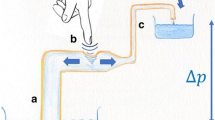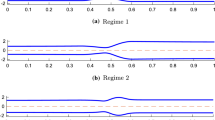Abstract
Valveless, tubular pumps are widespread in the animal kingdom, but the mechanism by which these pumps generate fluid flow is often in dispute. Where the pumping mechanism of many organs was once described as peristalsis, other mechanisms, such as dynamic suction pumping, have been suggested as possible alternative mechanisms. Peristalsis is often evaluated using criteria established in a technical definition for mechanical pumps, but this definition is based on a small-amplitude, long-wave approximation which biological pumps often violate. In this study, we use a direct numerical simulation of large-amplitude, short-wave peristalsis to investigate the relationships between fluid flow, compression frequency, compression wave speed, and tube occlusion. We also explore how the flows produced differ from the criteria outlined in the technical definition of peristalsis. We find that many of the technical criteria are violated by our model: Fluid flow speeds produced by peristalsis are greater than the speeds of the compression wave; fluid flow is pulsatile; and flow speed have a nonlinear relationship with compression frequency when compression wave speed is held constant. We suggest that the technical definition is inappropriate for evaluating peristalsis as a pumping mechanism for biological pumps because they too frequently violate the assumptions inherent in these criteria. Instead, we recommend that a simpler, more inclusive definition be used for assessing peristalsis as a pumping mechanism based on the presence of non-stationary compression sites that propagate unidirectionally along a tube without the need for a structurally fixed flow direction.









Similar content being viewed by others
References
Anderson M (1968) Electrophysiological studies on initiation and reversal of the heart beat in Ciona intestinalis. J Exp Biol 49:363–385
Aranda V, Cortez R, Fauci L (2011) Stokesian peristaltic pumping in a three-dimensional tube with a phase-shifted asymmetry. Phys Fluids 23(081):901
Auerbach D, Moehring W, Moser M (2004) An analytic approach to the liebau problem of valveless pumping. Cardiovasc Eng Int J 4(2):201–207
Avrahami I, Gharib M (2008) Computational studies of resonance wave pumping in compliant tubes. J Fluid Mech 608:139–160
Baird A, King T, Miller LA (2014) Numerical study of scaling effects in peristalsis and dynamic suction pumping. Contemp Math 628:129–148
Berger MJ, Colella P (1989) Local adaptive mesh refinement for shock hydrodynamics. J Comput Phys 82(1):64–84
Berger MJ, Oliger J (1984) Adaptive mesh refinement for hyperbolic partial-differential equations. J Comput Phys 53(3):484–512
Bringley T, Childress S, Vandenberghe N, Zhang J (2008) An experimental investigation and a simple model of a valveless pump. Physics of Fluids 20(033):602
Ceniceros HD, Fisher JE (2012) Peristaltic pumping of a viscoelastic fluid at high occlusion ratios and large Weissenberg numbers. J Non-Newton Fluid Mech 171:31–41
Chi N, Bussen M, Brand-Arzamendi K, Ding C, Olgin J, Shaw R, Martin G, Stainier D (2010) Cardiac conduction is required to preserve cardiac chamber morphology. Proc Natl Acad Sci USA 107(33):14,662–14,667
Childress S (2009) An introduction to theoretical fluid mechanics, Courant Lecture Notes, vol 19. American Mathematical Society, Providence
Childs H, Brugger E, Whitlock B, Meredith J, Ahern S, Pugmire D, Biagas K, Miller M, Harrison C, Weber GH, Krishnan H, Fogal T,Sanderson A, Garth C, Bethel EW, Camp D, Rübel O, Durant M, Favre JM, Navrátil P (2012) VisIt: an end-user tool for visualizing and analyzing very large data. In: High Performancevisualization—enabling extreme-scale scientific insight. CRC Press, Boca Raton, pp 357–372
Christoffels VM, Moorman AFM (2009) Basic science for the clinical electrophysiologist. Circ Arrhythm Electrophysiol 2:195–207
Davidson B (2007) Ciona intestinalis as a model for cardiac development. Semin Cell Dev Biol 18(1):16–26
Forouhar AS, Liebling M, Hickerson A, Nasiraei-Moghaddam A, Tsai HJ, Hove JR, Fraser SE, Dickinson ME, Gharib M (2006) The embryonic vertebrate heart tube is a dynamic suction pump. Science 312(5774):751–753
Fung YC, Yih CS (1968) Peristaltic transport. ASME E J Appl Mech 35:669–675
Gashev A (2002) Physiologic aspects of lymphatic contractile function. Ann NY Acad Sci 979:178–187
Glenn J, King J, Hillyer J (2010) Structural mechanics of the mosquito heart and its function in bidirectional hemolymph transport. J Exp Biol 213:541–550
Goenezen S, Rennie M, Rugonyi S (2012) Biomechanics of early cardiac development. Biomech Model Mechanobiol 11:1187–1204
Greenlee K, Socha J, Eubanks H, Thapa G, Pederson P, Lee W, Kirkton S (2013) Hypoxia-induced compression in the tracheal system of the tobacco hornworm caterpillar, Manduca sexta L. J Exp Biol 216:2293–2301
Griffith B (2014) An adaptive and distributed-memory parallel implementation of the immersed boundary (ib) method. https://github.com/IBAMR/IBAMR
Griffiths D, Constantinou C, Mortensen J, Djurhuus J (1987) Dynamics of the upper urinary tract: II. The effect of variations of peristaltic frequency and bladder pressure on pyeloureteral pressure/flow relations. Phys Med Biol 32(7):832–833
Hanin M (1968) The flow through a channel due to transversely oscillating walls. Israel J Tech 6:67–71
Harrison J, Waters J, Cease A, Cease A, VandenBrooks J, Callier V, Klok C, Shaffer K, Socha J (2013a) How locusts breathe. Physiology 28:18–27
Harrison JF, Waters JS, Cease AJ, VandenBrooks JM, Callier V, Klok CJ, Shaffer K, Socha JJ (2013b) How locusts breathe. Physiology 28(1):18–27
Hickerson AI, Rinderknecht D, Gharib M (2005a) Experimental study of the behavior of a valveless impedance pump. Exp Fluids 38(4):534–540
Hickerson AI, Rinderknecht D, Gharib M (2005b) Experimental study of the behavior of a valveless impedance pump. Exp Fluids 38(4):534–540
Jaffrin M, Shapiro A (1971) Peristaltic pumping. Annu Rev Fluid Mech 3:13–37
Jung E, Peskin CS (2000) Two-dimensional simulations of valveless pumping using the immersed boundary method two-dimensional simulations of valveless pumping using the immersed boundary method. SIAM J Sci Comput 23(1):19–45
Jung E, Lee S, Lee W (2008) Computational models of valveless pumping using the immersed boundary method. Comput Methods Appl Mech Eng 197:2329–2339
Kalk M (1970) The organization of a tunicate heart. Tissue Cell 2:99–118
Krenn H (2010) Feeding mechanisms of adult Lepidoptera: structure, function, and evolution of the mouthparts. Annu Rev Entomol 55:307–327
Kriebal M (1967) Conduction velocity and intracellular action potentials of the tunicate heart. J Gen Physiol 50(8):2097–2107
Lee W, Socha J (2009) Direct visualization of hemolymph flow in the heart of a grasshopper (Schistocerca americana). BMC Physiol 9:2. doi:10.1186/1472-6793-9-2
Lee W, Lim S, Jung E (2012) Dynamical motion driven by periodic forcing on an open elastic tube in fluid. Commun Comput Phys 12:494–514
Liebau G (1954) Über ein ventilloses pumpprinzip. Naturwissenschaften 41:327–327. doi:10.1007/BF00644490
Liebau G (1955) Die stromungsprinzipien des herzens. Z Kreislaufforsch 44:677
Liebau G (1957) Die bedeutung der tragheitskrafte fur die dynamik des blutkreislaufs. Z Kreislaufforsch 46:428
Maes F, Chaudhry B, Ransbeeck PV, Verdonck P (2011) The pumping mechanism of embryonic hearts. IFMBE Proc 37:470–473
Männer J, Wessel A, Yelbuz T (2010) How does the tubular embryonic heart work? Looking for the physical mechanism generating unidirectional blood flow in the valveless embryonic heart tube. Dev Dyn 239:1035–1046
Paff G (1938) The beahvior of the embryonic heart in solutions of ouabain. Am J Physiol 122(3):753–758
Paff G, Boucek R, Klopfenstein H (1964) Experimental heart-block in the chick embryo. Anat Rec 149:217–223
Peskin CS (2002) The immersed boundary method. Acta Numer 11:479–517
Postma AV, Christoffels VM, Moorman AFM (2008) Developmental aspects of the electrophysiology of the heart: Function follows form. In: Gussak I, Antzelevitch C, Wilde AAM, Powell BD, Ackerman MJ, Shen W-K (eds) Electrical diseases of the heart. Springer, London, pp 24–36
Pozrikidis C (1987) A study of peristaltic flow. J Fluid Mech 180:515–527
Rottbauer W, Baker K, Wo Z, Mohideen M, Cantiello H, Fishman M (2001) Growth and function of the embryonic heart depend upon the cardiac-specific L-type calcium channel \(\alpha \)1 subunit. Dev Cell 1:265–275
Santhanakrishnan A, Miller LA (2011) Fluid dynamics of heart development. Cell Biochem Biophys 61(1):1–22
Shapiro A, Jaffrin M, Weinberg S (1969) Peristaltic pumping with long wave lengths at low Reynolds number. J Fluid Mech 37:799–825
Taber LA (2001) Biomechanics of cardiovascular development. Annu Rev Biomed 3:1–25
Taber LA, Zhang J, Perucchio R (2007) Computational model for the transition from peristaltic to pulsatile flow in the embryonic heart tube. J Biomech Eng 129:441–449
Team RDC (2011) R: A Language and Environment for Statistical Computing. R Foundation for Statistical Computing, Vienna, Austria. http://www.r-project.org/edn
Teran J, Fauci L, Shelley M (2008) Peristaltic pumping and irreversibility of a Stokesian viscoelastic fluid. Phys Fluids 20(073):101
Vogel S (2007) Living in a physical world X. Pumping fluids through conduits. J Biosci 32(2):207–222
Waldrop L, Miller LA (2015) The role of the pericardium in the valveless, tubular heart of the tunicate, ciona savignyi. J Exp Biol (in press)
Xavier-Neto J, Castro R, Sampaio A, Azambuja A, Castillo H, Cravo R, Simoes-Costa M (2007) Parallel avenues in the evolution of hearts and pumping organs. Cell Mol Life Sci 64:719–734
Xavier-Neto J, Davidson B, Simoes-Costa M, Castillo H, Sampaio A, Azambuja A (2010) Heart Development and Regeneration. In: Evolutionary origins of the heart, vol. 1, 1st edn, Elsevier Science and Technology, London, pp 3–38
Acknowledgments
The authors would like to thank Boyce Griffith for his assistance with the use of IBAMR and to William Kier for his thoughtful advice on this project over the years. This work was funded by a NSF DMS CAREER # 1151478 (to L. Miller) and by a NSF DMS Research and Training Grant # 5-54990-2311 (to R. McLaughlin, R. Camassa, L. Miller, G. Forest, and P. Mucha).
Author information
Authors and Affiliations
Corresponding author
Rights and permissions
About this article
Cite this article
Waldrop, L., Miller, L. Large-amplitude, short-wave peristalsis and its implications for transport. Biomech Model Mechanobiol 15, 629–642 (2016). https://doi.org/10.1007/s10237-015-0713-x
Received:
Accepted:
Published:
Issue Date:
DOI: https://doi.org/10.1007/s10237-015-0713-x




